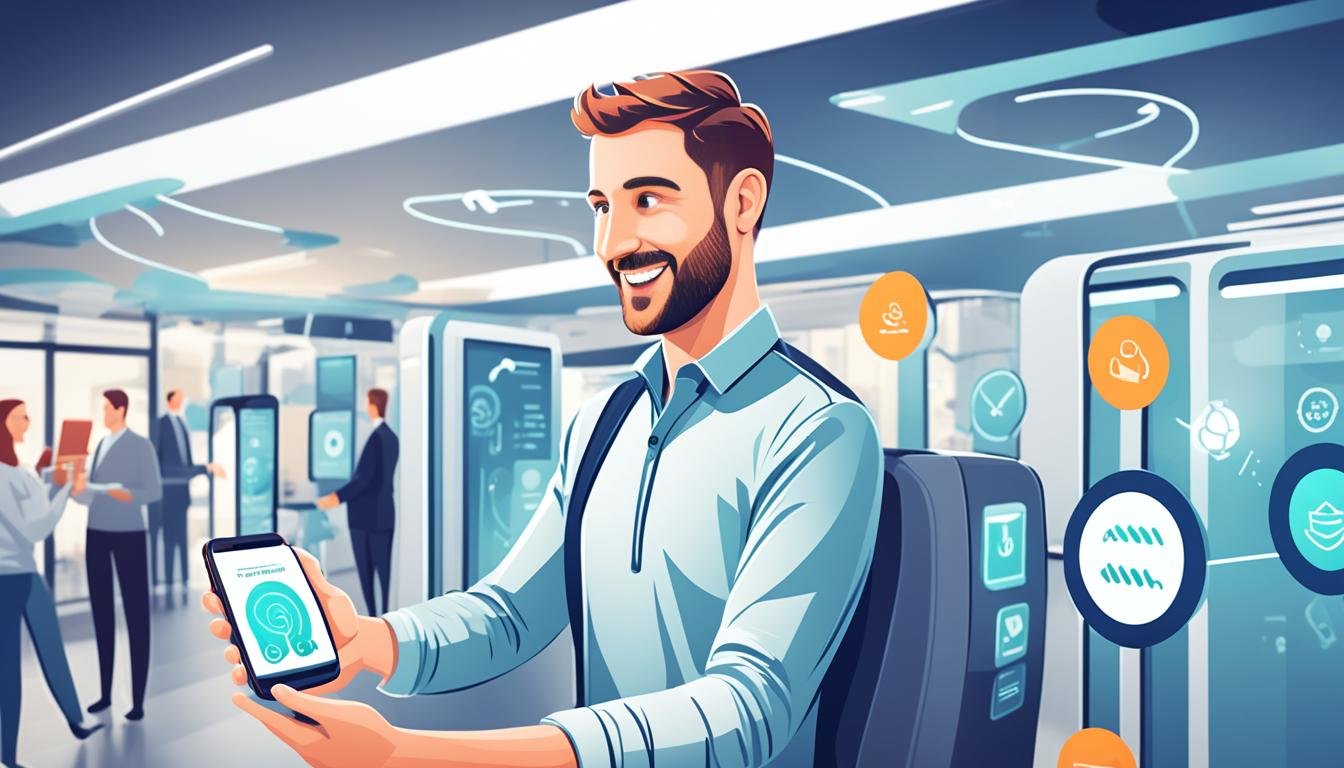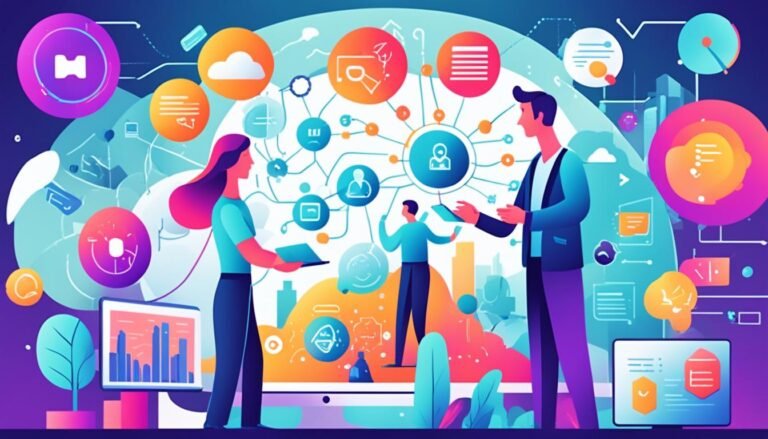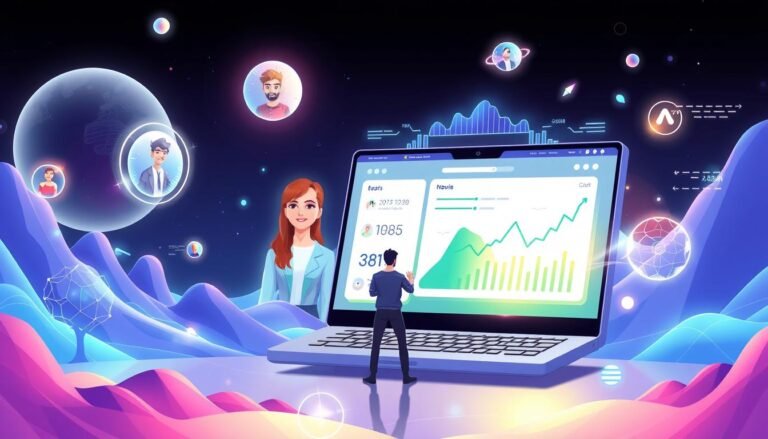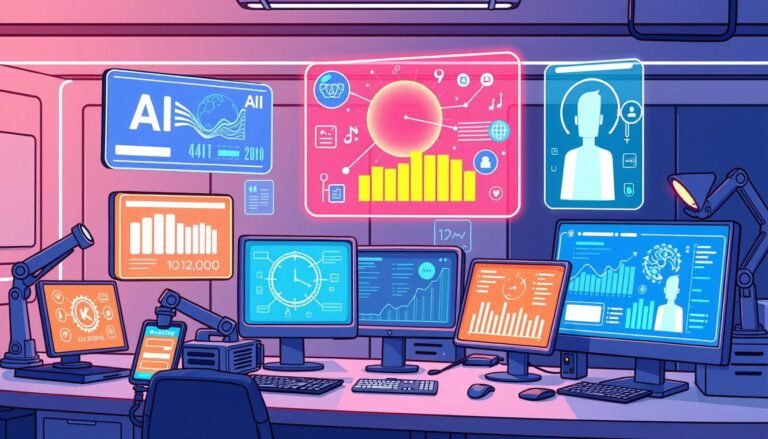AI and the Customer Journey: From Awareness to Advocacy
In today’s world, people want tailored and smooth experiences with brands. Yet, most big companies aren’t nailing this, with only a few over 30% saying their digital customer experiences are “good.”Now, what if I said artificial intelligence (AI) could change this?
Think about using AI to turn things around. With AI, we could improve customer experiences, keep customers coming back, and create marketing that feels more personal. It’s about unlocking AI’s power to shake up how we connect with clients.
AI is set to change how businesses engage with customers. This tech can make every interaction feel unique, streamline marketing efforts, and offer insights that make the customer journey smoother. It’s about seeing what AI can really do.
Want to know more about the AI promise in the customer journey? We’re just getting started on the exciting possibilities. Let’s see how AI can help your business succeed in new ways.
Key Takeaways:
- AI can transform the customer journey from awareness to advocacy
- Personalized marketing and engagement strategies can enhance customer experience
- AI technologies enable automation and optimization of marketing processes
- Unlock valuable insights to deliver a seamless customer journey
- Using AI in the customer journey can drive business success
Ready to use AI and change your customer journey for the better? AI holds a lot of promise. Let’s jump into how it can take your business to new levels.
Understanding the Digital Customer Journey
The digital customer journey has five main stages: awareness, consideration, purchase, experience, and loyalty. Each stage is crucial. They help customers through the process from first learning about a product to becoming loyal to it.
Stages of the Digital Customer Journey
- Awareness:
- Customers find out about a product in many ways. This includes social media, word of mouth, and emails. This step is key as it starts the customer’s journey.
- In this stage, customers learn as much as they can about the product. They look at websites, talk to chatbots, and read free trials. This helps them make smart choices.
- Customers finally buy the product in this stage. They might make accounts, fill shopping carts, and leave reviews. It’s important for this process to be easy and pleasant for them.
- Now, customers focus on their experience after buying. This includes delivery and support. Every interaction should be positive to keep them coming back.
- The goal here is to make customers keep coming back. Things like loyalty programs and quality products help. This builds a strong relationship with the brand.
Understanding how the customer journey works is key for businesses. It lets them find important points to improve on. Offering great experiences and looking at how customers use different devices helps companies keep customers happy and loyal.
By following the customer journey, businesses learn a lot about their customers. They can see what customers like and what bothers them. This helps in making marketing better and giving customers what they need, which keeps them coming back.
The Importance of Customer Journey Mapping
Customer journey mapping is key to understanding and enhancing the customer’s experience. It helps organizations see how customers interact with their brand. This understanding leads to spotting pain points, seeing things from the customer’s view, and making actions more personalized.
It also helps different teams within an organization work better together. By getting everyone involved in mapping the journey, it breaks down barriers. This allows for a complete picture of the customer and delivers a smoother experience overall.
“By mapping out the customer journey, organizations can identify pain points, empathize with the customer’s perspective, and create a seamless experience.”
Customer journey mapping is also great for shaping content. Knowing how customers move through their journey helps to create content that speaks to them. This makes the brand’s message more effective at every step.
In addition, it aids in predicting what customers will want in the future. By looking at their past interactions, organizations can guess their next needs. This helps fine-tune marketing and makes the experience more personal and engaging.
Lastly, it shines a light on where the journey might hit a bump. Finding spots where customers get stuck or feel frustrated is crucial. It allows the organization to improve those areas, leading to happier customers.
To sum up, mapping out the customer journey is crucial for bettering their experience. It uncovers issues, encourages teamwork, shapes content, foresees behaviors, and spotlights where to enhance. Using these insights, organizations can offer a fluid and tailored experience. This not only boosts satisfaction but also keeps customers coming back.
Creating a Digital Customer Journey Map
Making a digital customer journey map is key to seeing things from the customer’s view. It lets you track their path from first learning about your brand to buying and after. This helps improve each step of their experience.
Knowing the sales funnel is crucial for this. This shows the steps a customer takes before they buy. It’s about finding where and how they connect with your brand.
To really nail the map, you must think like your customer. Go through every step of the journey. This will reveal any problems and chances to make things better. Make sure these steps match what your company offers and what your audience wants.
Understanding your customers is where research steps in. Surveys and social media tracking give you insights on what customers like and don’t. This data guides how you design their journey, making it smoother and more enjoyable.
Creating personas is another vital part. These are made-up characters that stand for different customer types. They help you design the map in a way that each customer group gets a unique and good experience. This connection makes customers happier and more loyal.
Using mapping software can really speed things up. This tech offers charts and insights that let you see the journey clearly. It makes tweaking touchpoints and improving customer service easier.
Example Digital Customer Journey Map
| Stage | Touchpoints |
|---|---|
| Awareness | Social media ads Email marketing Word of mouth |
| Consideration | Website visits Chatbot interactions Online reviews |
| Purchase | Transaction Account creation Product review |
| Experience | Order fulfillment Shipping and delivery Support content Social media interactions |
| Loyalty | Loyalty programs Personalized rewards Quality assurance |
Data Collection in Digital Customer Journey Mapping
Digital customer journey mapping is about collecting various types of data. This helps us see how customers behave. By looking at this data, companies can predict and even change customer behavior. They can also find where they need to improve the customer journey.
Here are some of the data types you can collect:
- Web-browsing data: This includes what pages customers look at, how long on each, and what they click on the most.
- Mobile app data: Focuses on how customers use mobile apps. For example, which features they use, how long they stay on them, and what they buy in-app.
- Sales data: Looks at what customers buy, when, and how much money they spend on different products or services.
- Advertising data: Shows how well marketing works. This involves looking at views, clicks, how many people buy after an ad, and how much money those ads make.
- Loyalty data: Tells us about customer loyalty programs. It shows how often customers use rewards and how loyal they are overall.
- Survey data: Lets you ask customers directly what they like, what bothers them, and what they prefer. Surveys can tell us a lot about what customers want and need.
- Social media listening: It involves checking social media for what customers say about a brand or product. This can show positive and negative trends.
- Aftersales data: Looks at the support customers get after buying. This includes feedback, support tickets, and how long it takes to solve problems.
Using these data types, companies can fully understand the customer journey. They use this knowledge to improve the customer experience. This can lead to better personalization in marketing, increased satisfaction with the brand, and more loyal customers.
Benefits of Customer Journey Mapping
Mapping the customer journey gives companies many advantages. It helps improve customer experiences and marketing. This process involves analyzing each step a customer takes and how they feel along the way. Companies gain insights and close any gap, leading to better customer satisfaction.
- Gaining insights into the customer experience: Mapping out the customer journey helps companies understand their customers better. It shows where customers face issues or feel annoyed. This knowledge is key to making the journey smoother and more enjoyable.
- Fostering a seamless experience: A seamless experience is vital for trust and loyalty. Through mapping, companies find ways to improve the customer journey. This ensures customers can smoothly move from one step to the next.
- Informing content marketing strategies: Knowing the customer journey helps in crafting better content. It shows the points where customers interact with the content. This helps companies create content that attracts customers and leads them to buy.
- Predicting customer behavior: Mapping customer journeys helps predict what customers might do next. It highlights their usual steps and interactions. Knowing these, companies can prepare for and meet customer needs before they even ask.
- Identifying gaps in the customer journey: Companies can find and fix any missing or weak points in the journey. This could be confusing information or places where interactions fail. Spotting these flaws helps in creating a smoother and more consistent journey.
Customer journey mapping is a key strategy. It lets companies learn, create smooth experiences, better marketing, understand customer behavior, and improve journey gaps. Focusing on the customer journey boosts engagement and loyalty.
Example Table:
| Benefit | Description |
|---|---|
| Gaining insights into the customer experience | Mapping out touchpoints to identify areas of challenges or friction |
| Fostering a seamless experience | Ensuring customers can navigate through each stage with ease |
| Informing content marketing strategies | Creating relevant and impactful content at each touchpoint |
| Predicting customer behavior | Anticipating customer needs and tailoring marketing efforts accordingly |
| Identifying gaps in the customer journey | Detecting missing touchpoints, unclear messaging, or ineffective interactions |
How to Create an Optimal Customer Journey Map
It’s important for businesses to make a good customer journey map. This map shows the stages customers go through when they buy something. It helps companies know what customers want and make their experience better.
To build a great customer journey map, here’s what you should do:
Step 1: Conduct Comprehensive Customer Research
Start by learning a lot about your customers. Look at what they’ve bought before and ask them what they like and don’t like. This info will show you what your customers need and want at each step of their journey.
Taking the customer’s point of view into account lets you make a map that suits them.
Step 2: Identify Key Journey Stages
Next, figure out the main steps your customers take. This usually goes from when they first find out about you, to when they decide to buy, and beyond. Knowing these steps will let you see what parts of the journey are most important to them.
Step 3: Map Out Touchpoints
Show all the ways customers connect with you. Think about things like visiting your website, talking on social media, and calling for help. Make sure to cover all the ways your customers might reach out.
Step 4: Listen to the Voice of the Customer
Listening to what customers say is key. Reach out for feedback with surveys and talk to them directly. This helps you make changes that match what they want, making their journey more personal.
Step 5: Visualize the Journey through Graphical Representations
After you’ve gathered all your data, make it into a clear picture. Use graphs and diagrams to show the journey and its key points. This helps everyone involved understand and work to make things better for the customer.
Keep your customer journey map updated to make sure it’s always serving your customers well. The way customers interact with you can change, so staying adaptable is vital.
The Role of Improvado in Customer Journey Mapping
Improvado is a key player in making customer journey mapping easier. It helps organizations understand their customers better. By using Improvado, they can develop journey maps that improve the overall customer experience.
One important thing about Improvado is how it pulls together data from different sources. It connects with websites, social media, and CRM systems. This gives businesses a complete look at how customers interact with them. They can see every step of the customer journey and learn from it.
Improvado is also great at creating custom journey maps for different customer types. This means businesses can focus their marketing on what each customer group needs and likes. It helps them reach customers in a more personal way.
The Power of Visualization
What’s really cool is how Improvado presents all this data in a visual way. It works with BI and other tools to turn data into easy-to-understand maps. These maps help everyone get a better picture of the customer journey. They can spot trends and opportunities for making things better.
The way Improvado shows journey maps makes it easy for teams to understand and use them. Good visuals help get everyone on the same page. They can make better decisions and take actions that improve how customers feel.
Overall, Improvado gives businesses a powerful set of tools for understanding and improving the customer experience. With all its features working together, businesses can truly connect with their customers throughout their journey.
The Benefits of Improvado in Customer Journey Mapping
Improvado brings several advantages when used for customer journey mapping:
- Comprehensive insights: Improvado provides a consolidated view of customer interactions and touchpoints, enabling businesses to gain comprehensive insights into the customer journey.
- Personalized experiences: With Improvado’s customer segmentation and profiling features, businesses can create personalized journey maps that cater to the unique needs and preferences of different customer segments.
- Data-driven decision-making: Improvado’s data integration and visualization capabilities enable data-driven decision-making, empowering businesses to make informed choices and optimize touchpoints effectively.
- Improved customer engagement: By understanding the customer journey and optimizing touchpoints, businesses can enhance customer engagement, satisfaction, and loyalty.
- Streamlined processes: Improvado eliminates manual data collection and aggregation processes, saving time and resources so that organizations can focus on analyzing and utilizing insights to drive growth.
Through its features, Improvado helps businesses significantly enhance their customer experience efforts. It facilitates sophisticated customer journey mapping and encourages the use of data for insightful, effective decision-making.
| Improvado Features | Benefits |
|---|---|
| Data Integration | Gain a consolidated view of customer interactions and touchpoints |
| Customer Segmentation | Create personalized journey maps for different customer segments |
| Data Visualization | Transform raw data into clear and interactive journey maps |
| Streamlined Processes | Save time and resources through automated data collection and aggregation |
Best Practices for Effective Customer Journey Mapping
To make a detailed customer journey map, it’s vital to follow some key steps. First, you need to understand who your customers are. This is done by creating personas. These are fictional characters that represent the variety in your customer base. By using personas, you can understand what different customers want and need.
Next is about working together across departments. Everyone, from the marketing team to customer service, has a role. They all add pieces to the puzzle of the customer journey. Working as a team, they can shape a better experience for the customer.
It doesn’t stop there. Customer journey maps must always be up to date. This means adding new info and checking in with customers’ feedback. By keeping the map fresh, you’re making sure your strategies stay on target.
Understanding Customer Personas
When making a customer journey map, remember not all your customers are alike. Each persona shows you different needs and wants. This helps you tailor your map to meet each group’s specific needs. Thus, providing a personalized approach in the journey design.
Cross-Departmental Collaboration
Creating a map involves many teams working together. For the customer journey to run smoothly, everyone needs to be on the same page. Each team brings a valuable perspective. This collaboration is key to ensuring a customer-centric experience.
Regular Updates and Feedback
Customer journey maps need constant care. They should reflect the latest in customer trends and demands. It’s crucial to listen to what your customers are saying. Their feedback guides you in offering an evolving exceptional experience.
“By tailoring the customer journey map to specific personas and fostering cross-departmental collaboration, organizations can deliver personalized experiences and gain insights into the customer journey.”
Following these best practices helps organizations make meaningful maps. These maps then assist in truly understanding the customer, fixing any pain points, and delivering a smooth journey at every turn.
Conclusion
AI has changed how companies connect with their customers. It lets businesses make experiences that each customer values. Using technology this way makes people happier and helps the company’s marketing work better.
Companies can now use AI for better customer relationships. They understand more by looking at data. This helps them create experiences that each person likes more. By improving how they use AI data, businesses can do well even in tough markets.
Technology keeps getting better, and companies need to use AI in their plans. AI can make experiences more personal. This makes customers happier and marketing more effective for each person. Knowing the customer’s journey and using AI right can help a company succeed and keep its customers happy.







